Abstract
The article provides insight into the procedural and theoretical framework of a study conducted by the Palacky University Olomouc – Faculty of Education, into factors that affect the learning and academic achievement of children (pupils). It focuses on the differences in basal (partial) functions measured using the established methodology of B. Sindelar diagnostic and re-educational exercises. These were measured among first-grade students who were either neurotypical, had been diagnosed with deficiencies of partial functions (DPF) or were suspected of having such deficiencies. The exercises stimulating the development of partial functions which are also the specific assessment tools are described in detail allowing for replicability of the study. With reference to the research results, we may accept one of the premises of a part of our analysis – namely that, in certain subtests of the B. Sindelar test battery, significant differences were found in the test performance between the groups. Neurotypical students achieved better than students with DPF and students with suspected DPF. Such results suggest that the assessment tools are sensitive in recognizing deficiencies whether diagnosed or suspected. Differences between the DPF group and suspected DPF group were not straightforward. In some subtests, students diagnosed with DPF performed better, suggesting that interventions using the Sindelar methodology can lead to improvements in those functions. However, in some subtests, students with suspected DPF performed better, suggesting that their deficiencies were less severe in those areas than in the students with diagnosed DPF.
Keywords: Deficiencies of partial functions, neurotypical development, supportive measures, suspicion, visual stimulus material
Introduction
This article analyses the partial results of a multi-year study carried out by the Palacky University Olomouc, Institute of Special Education Studies which focuses on factors that affect the dynamics of learning among children and students who require special-educational supportive measures – in other words, students with special educational needs. This specific analysis focuses on the differences in the dynamics of partial (basal) functions among first-grade students who had been diagnosed with deficiencies of partial functions, those suspected of having such deficiencies, with the third major study group (the normative group) comprised of neurotypical peers.
Problem Statement
The starting point for comparing the data from these specific groups of first-graders were the findings from a smaller-scale preliminary research carried out as part of the overall project – namely that students with diagnosed disorders performed better with some of the B. Sindelar stimulus materials than neurotypical students. The premise of our research is to consider whether this could be the case because re-educated students diagnosed with deficiencies of partial functions (DPF) are more familiar with this stimulus material than neurotypical students. To test for this, we put together a group of students who were suspected of having DPF, which included students suspected of having DPF (based on the qualified judgement of their homeroom teacher) and those who had been recently diagnosed (within the last 3 months) and, as a result, have not yet received significant intervention.
Research Questions
The aim of the study is to identify; describe and compare determinants of learning and its dynamics in children and students with needs for special-educational support measures.
The secondary goal of this analysis is to produce a comparison of the results of Sindelar subtests between neurotypical students, students with DPF and students suspected of having DTF which could be used to observe whether there are statistically significant differences (and if so, between which groups of respondents).
The subject of this analysis were visual stimulus materials (subtests) of the Sindelar battery. Subtests employed stimulus material by Sindelar (2007a, 2007b) published as the Diagnostic method for detecting partial function deficits in school children – handbook and described in other publications.
Participants
The research was conducted in four Moravian regions and in the capital city Prague. The selection of students from the population of first-grade elementary school students for the study sample was done through deliberate institutional selection (Pedagogical and Psychological Counseling, Special Education
Centres, elementary schools, Dyscentrum), with a total of 613 first-grade elementary school pupils. Out of these 422 were neurotypical; 119 were suspected of having deficiencies or had been recently diagnosed; 72 had DPF.
Survey instrument
As it was mentioned above, selected subtests by Sindelar (2007b) were used for this purpose: children – handbook.
These comprised:
Stimulus material for the visual classification subtest (copying a shape), subtest B of the test battery;
Stimulus material for the visual differentiation of image pairs, subtest D of the test battery;
Stimulus material for visual memory subtest – pictures, subtest Ga of the test battery;
Stimulus material for visual memory subtest – shapes, subtest Gb of the test battery.
Purpose of the Study
The theoretical framework of this research is based on the theory of deficiencies of partial (basal) functions (DPF) of Affolter (1972) and Sindelar (1985, 2000) and Sindelar et al. (2018) and the additional observations of partial performance reduction by Scharinger and Scharinger (1994). The general theoretical basis of the research is in neuropsychology, cognitive psychology and ontogenetic psychology.
The need for further insight into this issue stems from the lack of this or similar kind of research in the Czech Republic, despite the fact that – according to research conducted elsewhere (Affolter, 1972; Roloff, 1989 as cited in Sindelar, 2000; Sindelar et al., 2018) – deficiencies of basal functions affect 15-20% of school-age children and significantly contribute to failures at school due to being the determiners of, among other things, specific developmental disorders of scholastic skills and of a wide range of emotional disorders in childhood and adolescence. Converting these statistics into numbers, for the Czech Republic, this would mean that roughly 200,000 children and students are affected by DPF (OECD, 2019; Santiago et al., 2012). We do not know the actual prevalence – learning this prevalence falls under the survey part of the research project. However, studies from other countries (such as Carroll et al., 2003; Flanagan et al., 2018; Layes et al., 2021; Mohamed et al., 2021) repeatedly point to the fact that improving partial cognitive functions – including phonemic awareness, morphological awareness, visual differentiation etc. – positively affects the acquisition of reading and writing skills. Šilonová et al. (2021) provided evidence that using the Sindelar (2000) methodology is an effective intervention strategy for children from socially disadvantaged backgrounds. In other words, supporting development and minimizing the listed deficiencies often plays a key role in the acquisition of the trivium and thus directly affects the future successfulness of students. In addition, all the listed skills can be divided into truly partial components. For example, research by Carroll et al. (2003) shows that the development of phonemic awareness is preceded by the development of syllabification, the ability to separate the first vowel from the rest of the word and the development of articulatory skills. A recent study by Ray et al. (2021) confirmed the links between foundational skills needed for handwriting such as perceptual and motor skills and the development of literacy, including phonological skills. Grofčíková and Máčajová (2021) also verified that phonological and phonemic awareness predicted literacy skills (reading and writing) and therefore suggested that partial functions need to be assessed and supported through targeted interventions. Similarly, Rezaei et al. (2020) confirmed the effectiveness of training in partial functions, specifically auditory discrimination, in improving the skills of students with dyslexia. Other programmes focused on developing foundational partial skills for handwriting (Taverna et al., 2020) and visual-spatial skills (Brock et al., 2018) proved to be effective, not only for learning but behaviour too.
Adequate maturation and harmonious development of partial (basal) functions are a prerequisite for the development of more complex processes and acquisition of the complex skills belonging to the trivium – the ability to read, write and count. Deficiencies of partial functions (DPF) are thus one of the causes of specific learning and behavioral disorders. For example, Cheng et al. (2018) reported visual deficits in both individuals with dyslexia and dyscalculia.
Graichen (1973) defined DPF as a reduction in the performance of individual factors or elements within a larger functional system that are necessary for the acquisition of certain complex adaptation processes. However, this general definition of the phenomena includes a far too wide range of disorders and as a result, the entire concept was narrowed down and specified for the purposes of counselling and practical special education.
Partial functions (as simplified for the purposes of this research project) include a cluster of ten functions – a deficiency in either one of them can affect the learning of a given student through a corresponding symptom (repeating mistakes, for example, in spelling or reading).
Sindelar (2000) clearly illustrates the individual partial functions on an example of a second-grader's dictation exam. In order for the child to write the dictated sentence correctly, the child needs to:
- distinguish the teacher's voice from other environmental sounds (auditory attention – auditory differentiation figure-background);
- briefly hold the spoken sentence in (auditory) memory;
- divide the word into sounds – phonemes (auditory analysis);
- differentiate the individual phonemes from similar phonemes (auditory differentiation – phonemic hearing);
- choose the correct graphemes to represent the phonemes (visual memory);
- not confuse similar-looking graphemes (visual differentiation – graphomatic vision);
- connect the correct phoneme with the correct grapheme, i.e., connect interperceptive information (intermodal functions, the partial ability to create intermodal relationships);
- coordinate the fine the motor skills of fingers during writing (visual-motor coordination);
- place the letters into the correct section of the line (spatial orientation);
- not shuffle up the correct sequence of phonemes and graphemes and not forget either one of the listed activities (perception of time, sequencing).
Diagnosing DPF employs the above-described procedural scheme. Instrumentally, it uses established means of psychological and special-educational normative diagnostics (both clinical and counseling ones), with a preference for dynamic diagnostic means (Elliot et al., 2018; Feuerstein, 2018; Kim, 2020; Tzuriel, 2021).
Research Methods
Ad 1: Assignment: (place the pattern on the left for right-handed students and on the right for left-handed ones). Template – Figure 1. Evaluation: Following the manual, the drawing is evaluated with 0, 0.5, 1 or 2 points.

Ad 2: Assignment: “ (First, show the two alarm clocks where the difference is most apparent and ensure that the child understands the assignment. Do not tell the child if it makes a mistake. Put the new image over the previous one to prevent it from being distracting.) Stimulus material – Figure 2.
Evaluation – if the answer is that they are the SAME, circle A; if the answer is that they are DIFFERENT, circle N. Then add all the circled letters that have a 1 next to them, which will yield the point score (Table 1).
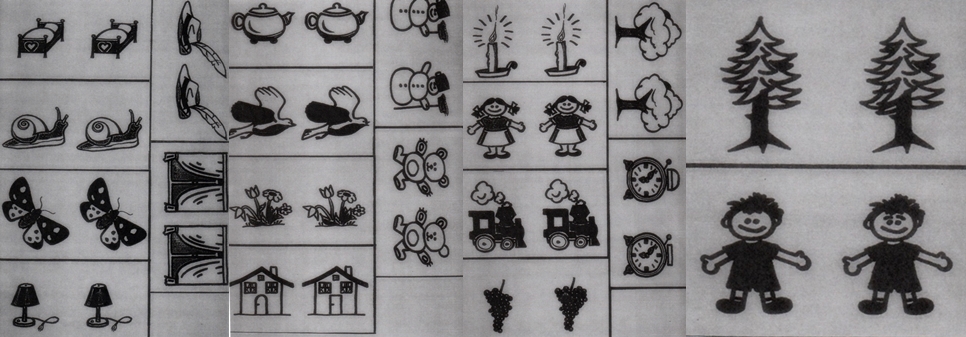
Ad 3: Assignment: (Place the cards in front of the child from left to right at the speed of one card every two second – proceed in the order found in the Table 2. Again, proceeding from left to right, turn over the cards, one by one, so that the images are no longer visible. Give the child a shuffled stack of cards with the same images on them and ask it to replicate the sequence of images – to help the child understand, you can compare it to the card game Concentration. Stimulus material: Figure 3. Evaluation – using initial letters enter the sequence in which the child arranged the cards into the table – assign one point per each correctly placed picture.
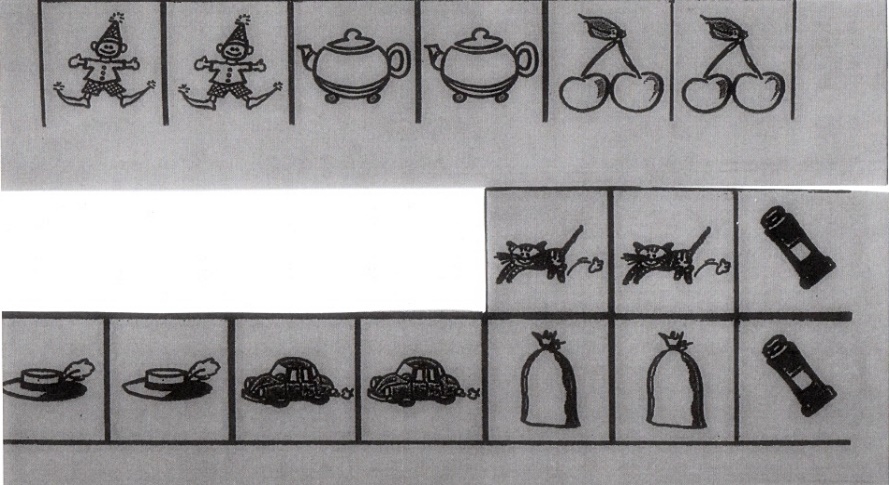
Ad 4: Assignment:Place the cards in front of the child from left to right at the speed of one card every two second – proceed in the order found in the Figure 4. Again, proceeding from left to right, turn over the cards, one by one, so that the shapes are no longer visibly. Give the child a shuffled stack of cards with the same shapes on them and ask it to replicate the sequence of images – to help the child understand, you can compare it to the card game Concentration. Stimulus material: Figure 5. Evaluation – using initial letters enter the sequence in which the child arranged the cards into the table – assign one point per each correctly placed shape. Evaluation – enter the sequence in which the child arranged the shapes into the table – assign one point for each correctly placed shape.

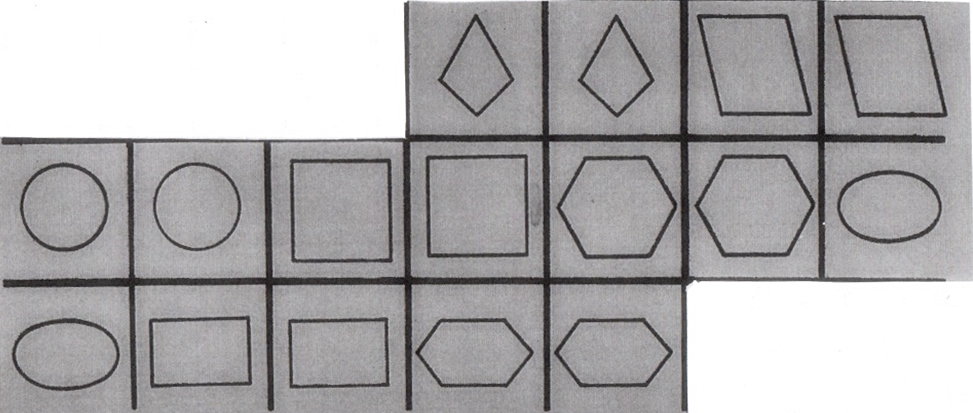
Findings
Ad. 1: Subtest B of the test battery – visual classification subtest (copying a shape). First-grade students (neurotypical vs. suspicion of DPF vs. DPF) (See Table 3 and Figure 6).
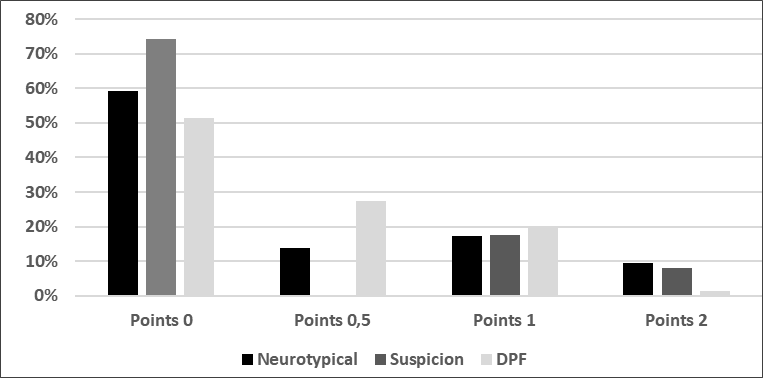
Statistically significant differences:
- neurotypical: Suspicion (p = 0.020);
- suspicion: DPF (p = 0.035).
Ad. 2: Subtest D of the test battery – visual differentiation of image pairs. First-grade students (neurotypical vs. suspicion of DPF vs. DPF) (See Table 4 and Figure 7).
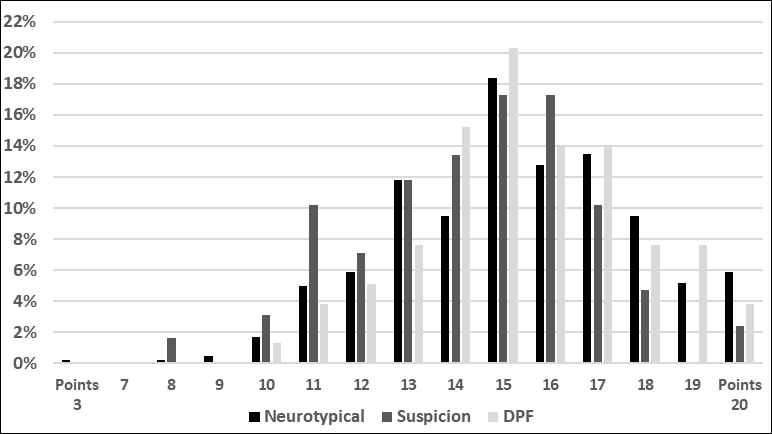
Statistically significant differences:
- neurotypical: Suspicion (p = 0.000);
- suspicion: DPF (p = 0.005).
Ad. 3: Subtest Ga of the test battery – visual memory (pictures). First-grade students (neurotypical vs. suspicion of DPF vs. DPF) (See Table 5 and Figure 8).
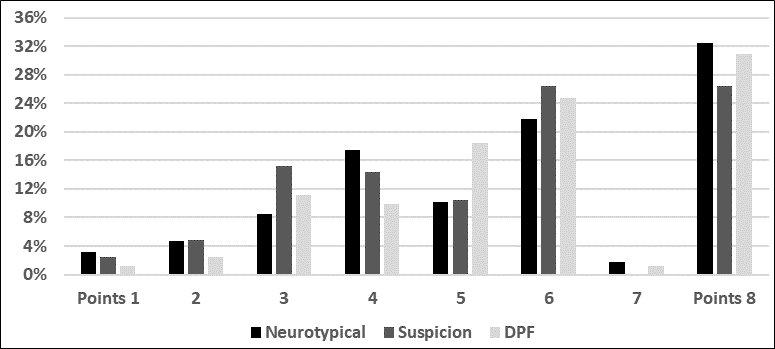
Ad. 4: Subtest Gb of the test battery – visual memory (shapes). First-grade students (neurotypical vs. suspicion of DPF vs. DPF) (See Table 6 and Figure 9).
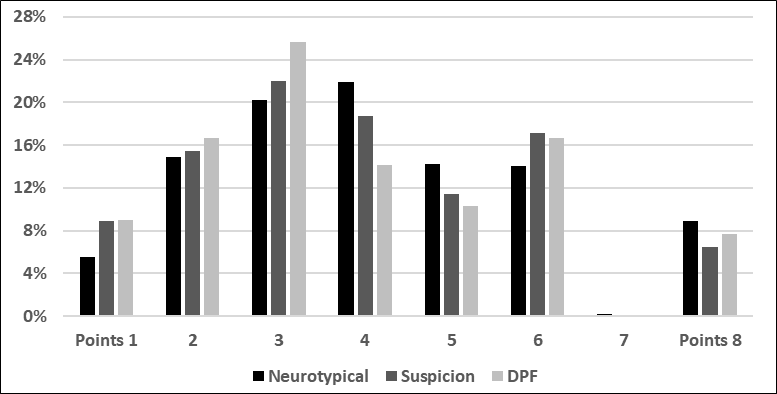
Statistically significant difference (Mann-Whitney test, p = 0.035)
Reliability:
- cronbach's alpha: .787253398;
- standardized alpha: .793981430.
Conclusion
The above tables and figures clearly show the distribution of data in sets focused on perception-visual partial functions – a comparison of neurotypical first-grade students vs. those suspected of DPF vs. diagnosed with DPF.
The statistical significance of differences in the response set is indicated (incl. the significance p) below the frequency tables in cases where the statistical test showed a difference.
Statistically significant differences were found in the subtests:
- Subtest B: visual classification (copying a shape) with a significance of neurotypical students vs. students with DPF = .020 and students with suspicion of DPF vs. students with DPF = .035. The analysis shows that neurotypical students achieved better results than students from the other two groups (students suspected of having DPF achieved better results than those with DPF).
- Subtest D: visual differentiation of image pairs – significance neurotypical vs. suspicion of DPF = .000, students with suspicion of DPF vs. students with deficiencies = .005. Neurotypical students showed the best results, while students with deficiencies did better than students suspected of having deficiencies.
- Subtest Gb: visual memory – shapes, statistically significant difference p = 0.035, the best results were, again, achieved by the neurotypical students.
Statistical analysis of the data did not reveal any statistically significant differences for the subtest Ga (visual memory – pictures). Nevertheless, the frequency table shows that neurotypical students and students with DPF performed the best in this subtest.
From what has been stated above, we may generalize that in tests focused on visual memory, perception and differentiation, there are statistically significant differences between respondent groups in the subtests B, D and Gb (visual classification – copying a shape, visual differentiation of image pairs, visual memory – shapes). In contrast, the Ga subtest – visual memory for pictures – did not show any statistically significant differences.
In the individual subtest, neurotypical students scored the highest. Between students suspected of DPF and students with deficiencies, the suspected group achieved better results in subtest B (visual classification – copying a shape), while students with deficiencies did better in subtest D (visual differentiation of image pairs). The results of subtests focused on visual memory (Ga, Gb) did not show major differences between the two groups.
In contrast to auditory subtests (auditory memory and differentiation) and subtests of orientation within the body schema which, in prior research, showed clear right-side dominance (see distribution curve) of performances (i.e. the prevalence of average and above-average results), visual subtests show a different pattern – subtests D and Gb appeared somewhat balanced, subtest B appeared too difficult for the subjects and subtest Ga was too easy.
The study provides an insight into the basal partial functions that determine pupils’ learning at a young age. Gaining mastery, proficiency and confidence in these underlying functions leads to improvement in skills directly used in academic tasks such reading and writing. Thus, being involved in interventions focusing on these basal functions may improve children’s overall academic achievement. While from the study results, it is obvious that children with neurotypical development do well in tasks testing the partial functions, children with suspected or diagnosed special educational needs struggle to achieve the same results. In addition, the study provides evidence of the importance of early diagnosis that is connected with provision of interventions, because some children with diagnosed deficiencies performed better in certain subtests than children with suspected difficulties. This suggests that interventions focusing on enhancing the basal functions can improve children’s learning and contribute to school success for children who would otherwise be at risk of school failure.
Acknowledgments
The study is part of the project: VaV_PdF_2020_002 Faktory ovlivňující dynamiku edukability dětí a žáků s potřebou speciálněpedagogických podpůrných opatření.
References
Affolter, F. (1972). Entwicklung visueller und auditiver Prozesse [Auditory and visual process development]. Psychologie.
Brock, L. L., Murrah, W. M., Cottone, E. A., Mashburn, A. J., & Grissmer, D. W. (2018). An after-school intervention targeting executive function and visuospatial skills also improves classroom behavior. International Journal of Behavioral Development, 42(5), 474–484. DOI:
Carroll, J. M., Snowling, M. J., Stevenson, J., & Hulme, C. (2003). The development of phonological awareness in preschool children. Developmental psychology, 39(5), 913–923. DOI:
Cheng, D., Xiao, Q., Chen, Q., Cui, J., & Zhou, X. (2018). Dyslexia and dyscalculia are characterized by common visual perception deficits. Developmental neuropsychology, 43(6), 497–507. DOI:
Elliot, J. G., Resing, W. C., & Beckmann, J. F. (2018). Dynamic assessment: A case of unfulfilled potential? Educational Review, 70(1), 7–17. DOI:
Feuerstein, R. (2018). Cognitive assessment of the socioculturally deprived child and adolescent. In L. J. Cronbach, & P. J. D. Drenth (Eds.), Mental tests and cultural adaptation (pp. 263-276). De Gruyter Mouton.
Flanagan, D. P., Alfonso, V. C., Costa, M., Palma, K., & Leahy, M. A. (2018). Use of ability tests in the identification of specific learning disabilities within the context of an operational definition. In D. P. Flanagan, & E. M. McDonough (Eds.), Contemporary intellectual assessment: Theories, tests, and issues (pp. 608–642). The Guilford Press.
Graichen, J. (1973). Teilleistungsschwächen, dargestellt an Beispielen aus dem Bereich der Sprachbenutzung [Partial performance weaknesses, illustrated using examples from the area of language use]. Zeitschrift für Kinder-und Jugendpsychiatrie, 1, 113–143.
Grofčíková, S., & Máčajová, M. (2021). Rhyming in the context of the phonological awareness of pre-school children. CEPS Journal, 11(1), 115–138. DOI:
Kim, Y. S. G. (2020). Hierarchical and dynamic relations of language and cognitive skills to reading comprehension: Testing the direct and indirect effects model of reading (DIER). Journal of Educational Psychology, 112(4), 667–684. DOI:
Layes, P. S., Kaddouri, D. A., Lalonde, P. R., & Rebai, P. M. (2021). Effects of Morphological Awareness Training on Reading Accuracy in Children with Dyslexia and its Transfer Effect on Phonological Awareness. Journal of International Special Needs Education, 24(2) 66–75. DOI:
Mohamed, A. H. H., Hassan, A. S., Al-Qaryouti, I., Al-Hashimi, A., & Al-Kalbani, Z. (2021). The development of phonological awareness among preschoolers. Early Child Development and Care, 191(1), 108–122.
OECD (2019). OECD Education Policy Outlook 2019: Working Together to Help Students Achieve their Potential: Czech Republic. DOI:
Ray, K., Dally, K., Rowlandson, L., Tam, K. I., & Lane, A. E. (2021). The relationship of handwriting ability and literacy in kindergarten: a systematic review. Reading and Writing (2021), 1-37. DOI:
Rezaei, T., Hassanzadeh, S., & Sobhani, F. (2020). The Effectiveness of Auditory Training Program on Improving Phonological Skills, Auditory Discrimination and Articulation in Students with Dyslexia. Journal of Paramedical Sciences & Rehabilitation, 9(3), 19–30.
Santiago, P., Gilmore, A., Nusche, D., & Sammons, P. (2012). OECD Reviews of Evaluation and Assessment in Education: Czech Republic 2012. OECD Publishing.
Scharinger, J., & Scharinger, F. W. (1994). Dílčí oslabení výkonu – rozpoznávaní a vliv na školní praxi [Partial impairment of performance - recognition and influence on school practice]. Univerzita Karlova v Praze.
Šilonová, V., Klein, V., & Rochovská, I. (2021). Inclusive Diagnostics and Stimulation of Socially Disadvantaged Children of a Pre-School Age: Experimental Verification. Problems of Education in the 21st Century, 79(5), 804–825.
Sindelar, B. (1985). Vefahren zur Effasung von Teilleistungsschwächen [Procedure for recording partial performance weaknesses]. Eigenferlag.
Sindelar, B. (2000). Diagnosis and treatment practices in the field of ADD/ADHD/HD in Europe. Council of Europe Publishing.
Sindelar, B. (2007a). Deficity dílčích funkcí (Teoretická část) [Deficits of partial functions (Theoretical part)]. Psychodiagnostika.
Sindelar, B. (2007b). Diagnostická metoda k zjišťování deficitů dílčích funkcí u školních dětí (příručka) [Diagnostic method for detecting partial function deficits in school children (manual)]. Psychodiagnostika.
Sindelar, B., Aden, J., & Sindelar, C. M. (2018). Entwicklungsrisiko Rechtschreibschwäche (Legasthenie) [Developmental risk of spelling weakness (dyslexia)]. Zeitschrift für freie psychoanalytische Forschung und Individualpsychologie, (2), 73-96. DOI:
Taverna, L., Tremolada, M., Dozza, L., Zanin Scaratti, R., Ulrike, D., Lallo, C., & Tosetto, B. (2020). Who benefits from an intervention program on foundational skills for handwriting addressed to kindergarten children and first graders? International journal of environmental research and public health, 17(6), 2166. DOI:
Tzuriel, D. (2021). Dynamic Assessment (DA) of Learning Potential. In Mediated Learning and Cognitive Modifiability. Social Interaction in Learning and Development (pp. 69-88). Springer. DOI:
Copyright information

This work is licensed under a Creative Commons Attribution-NonCommercial-NoDerivatives 4.0 International License.
About this article
Publication Date
22 April 2022
Article Doi
eBook ISBN
978-1-80296-956-6
Publisher
European Publisher
Volume
3
Print ISBN (optional)
-
Edition Number
1st Edition
Pages
1-310
Subjects
Education quality, education assessment, education and city, urban education, lifelong learning, Big Data in education
Cite this article as:
Valenta, M., Mastalir, J., & Listiakova, I. L. (2022). Differences Between First-Grade Pupils in Partial Functions in Sindelar Visual Stimulus Tasks. In S. Vachkova, & S. S. Chiang (Eds.), Education and City: Quality Education for Modern Cities, vol 3. European Proceedings of Educational Sciences (pp. 182-194). European Publisher. https://doi.org/10.15405/epes.22043.17

